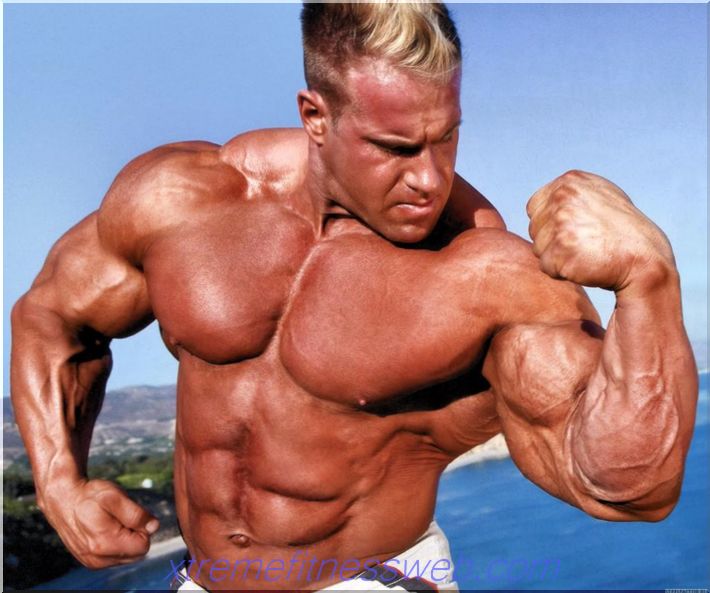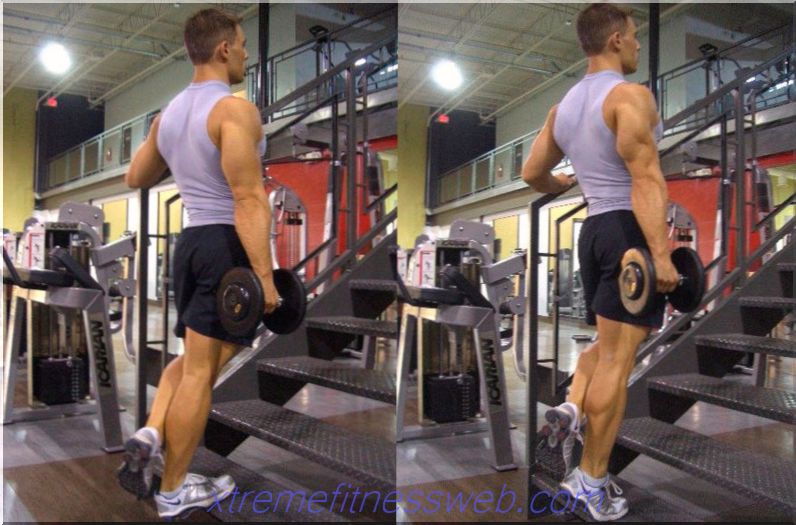- Execution technique
- Execution Options
- Parsing exercise
- Program Inclusion
- Contraindications
- Interesting fact
- Substitutions and related exercises

A concentrated rise in biceps can often be seen in the halls. It is believed that it is he who helps to pump the biceps to the peaks. But scientifically, the possibility of "appearance" of peaks on the arm of a person who is not genetically predisposed to this is not yet proven. However, exercise is popular. It allows you to use small and medium weights, and work out both biceps symmetrically.
Content
- 1 Technique
- 1.1 Recommendations
- 2 Options
- 3 Analysis of exercises
- 3.1 working muscles
- 3.2 Pros
- 3.3 Disadvantages
- 3.4 Preparation
- 3.5 Correct execution
- 3.6 Errors
- 3.7 Performance Tips
- 4 Inclusion in the program
- 5 Contraindications
- 6 Interesting fact
- 7 Substitutions and related exercises
Execution technique

Starting position
- The movement is performed from a sitting position;
- The athlete spreads his legs wide, performs a forward bend, rests his elbow on the thigh so that his position is fixed;
- The back remains straight, shoulders set aside from the ears;
- The free arm can rest on the knee or thigh
Traffic
- Due to the contraction of the biceps, the arm bends at the elbow joint;
- At the top point, at the peak of contraction, you can linger, straining your biceps;
- The arm extends slowly and in a controlled manner;
- Inhale - on lowering, exhale - on contraction;
- There is no pause below, you need to immediately move in the opposite direction, and again contract muscles;
- The movement is performed in the same number of repetitions
Attention
- It is better not to bend the wrist in the exercise, so as not to use the "extra" muscles and not to remove the load from the biceps;
- The movement is not "sharpened" for execution with significant weight weights. It will be better if it begins to be carried out with such a weight with which the rise will remain concentrated, and the elbow will not move relative to the hip;
- You should not take your elbow from your hip, otherwise the whole point of the exercise is lost;
- Dropping the dumbbell down and doing the extension aggressively, to the “click” in the joint is also not recommended;
- The body should not perform “swing” and movements that help push the weight up;
- You should not take the entire weight of the projectile “into the joint”, actively resting on the thigh with the elbow.
Recommendations
- This exercise is concentrated, you need to maximize the strain of your hand above, attention is focused on this;
- You should not select such a weight at which there is no way to independently remove the dumbbell from a lower position;
- It is better to place the legs so that there is a stable position, usually it is achieved when setting the feet wider than the shoulders;
- Bending your wrist up is a bad strategy leading to overloading your forearm;
- The amplitude should be large, this is not a reduced amplitude in exercises involving brachialis and brachradialis;
- The back should be kept neutral, the spine - as straight as possible, elongated, without deflection
Execution Options

- Lifting biceps while standing in a concentrated style . In fact, this exercise comes in two forms. The athlete can either use a support or bench to fix the forearm, or rest the elbow in the body so as to exclude movement in the forearm. Both options are recommended only with a healthy back, and are not used if there are problems;
- Rise with supination . This is the name for the classic lifting of dumbbells for biceps in a concentrated style while sitting, but when the athlete turns his hand palm up;
- Concentrated style climb sitting on Larry Scott's bench . Yes, this popular version with one dumbbell will completely copy a simple lift;
- Exercise on the bottom block . Using the handle of the lower block allows you to make bending even more targeted and concentrated. So the athlete will be able to provide constant tension and muscle work.
Parsing exercise
Working muscles

- The main mover is the biceps of the arm;
Assistant muscles - brachialis, forearm muscles.
pros
- This is the highest amplitude movement, it helps to stretch the biceps as much as possible;
- A simple inventory allows you to train at home or in the base room itself;
Many options for exercise help to perform the movement in any conditions; - Empirically it is proved that this exercise can make the arms more voluminous, and help with the construction of the "peak" of the biceps, although studies on the electromyograph do not prove this;
- Help is completely excluded due to buildup, elbows are fixed;
- There is variability - if you lift the dumbbell not with proned, but with supinated grip, you can use the brachioradialis muscle;
- The exercise is simple technically, does not require essential skills, can be performed by both beginners and pros.
disadvantages
- This exercise eliminates the use of substantial weights. It is intended to “hone" the form, and not to build large volumes of arm muscles. Training only with this movement is unlikely to be able to "swing" your hands
Training

In order to pump the biceps in a concentrated style, you must first stretch well. Despite the apparent simplicity, the exercise may not be safe if you perform it, actively adding working weight without warming up. Rarely does anyone start with a concentrated lift to the biceps, usually the back exercises or other movements for the biceps go first in training, and this exercise is somewhere closer to the end of the workout.
Concentrated style lifts are often used with different methods of increasing training volume and intensity. Some athletes like to do this exercise with dropset, others - only in 3-4 sets of 12-15 repetitions, but carefully monitoring each movement.
Correct execution

- Feet need to be parted as widely as possible. Too narrow setting of the legs in a sitting position can lead to blockage of the body in one direction or another. You should also actively raise your knees so that the position is stable. The optimal load will help to choose not only the correct spacing of the feet, but also the active inclusion of the muscles of the hips. Feet need to be repelled from the floor. At the same time, the bench should not be too high so that the knee joints are not bent at an obtuse angle;
- The movement is made only due to the forearm. The elbow rests on the thigh throughout the exercise, which ensures a stable position of the shoulder, and turning it off from work;
- This flexion should be performed with maximum concentration on the biceps, the athlete is fixed at the highest point and contracts muscles as much as possible;
- It is not necessary to drop the arm with the dumbbell down; it is recommended to lower it slowly and under control;
- Exhalation is carried out when lifting weight, inspiration - when lowering
Mistakes
- Body reading;
- Tearing off the hand from the hip;
- "Standing" on the elbow joint
Performance Tips
- This is a finishing exercise. All movements are performed with a relatively light weight. You can try to work "after failure", helping yourself with your free hand;
- In this exercise, 2-3 drop sets with lighter weight work effectively;
- Individual athletes like to use rubber shock absorbers for their biceps, putting them on their working arm and, as it were, "locking" the blood in their biceps to increase the load
Program Inclusion

This movement can hardly be put first in the plan. Few people start with it, except those who work their hands 3 times a week, and have one easy workout among all this abundance of biceps exercises. Some athletes tend to perform concentrated flexion with 2-3 movements, but this is not entirely true. By its nature, it can only be final.
Usually 2-3 sets of 10-12 repetitions per set are performed. Possible increase to 12-15, this is an individual indicator.
Contraindications
- Any injuries to the target muscle group, including tears and tears, which are quite typical for power sports, are a contraindication for training biceps;
- Good health of the ligaments of the elbow joint is also required. In addition, the inflammatory and degenerative processes in the elbows and wrists are an unambiguous contraindication for this movement.
Interesting fact
Scientists at the American College of Sports Medicine measured the activity of muscle fibers during biceps flexion. Concentrated lifting involves as much as 97% of muscle fibers. This is more than the classic standing barbell raises. But the study did not prove that this is the most effective exercise to gain total muscle mass of the hands. It is still believed that the best in this regard are pull-ups on the crossbar and standing ups on the biceps.
Substitutions and related exercises

A movement similar in biomechanics is lifting one dumbbell on Larry Scott's bench. Only the amplitude changes, it is smaller on Scott's bench, but the athlete can get more load due to an increase in working weights.
But most often, the movement is replaced by a concentrated rise in the biceps with one hand on the lower block of the crossover. A D-shaped handle is attached to the simulator rope, and the arm is bent, bringing the palm to the shoulder.
This exercise can be replaced with a concentrated lift with rubber shock absorbers, especially in training aimed at rehabilitation.
You can perform a concentrated rise in biceps in the usual style and with supination of the wrist. Turn your hand or not, everyone chooses independently. In this regard, athletes must carefully select the load for themselves. The movement should be included in the training of arms or back and biceps once a week, if the hands are trained 2 times a week and the athlete specializes, it makes sense to perform this movement in one training session, in the other - lifting on Scott's bench or another version of concentrated biceps flexion with a barbell.







